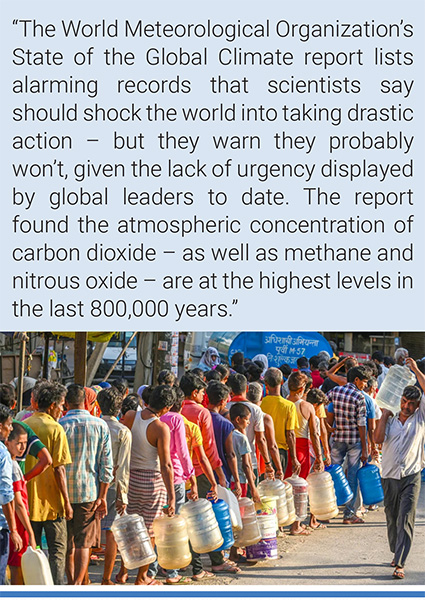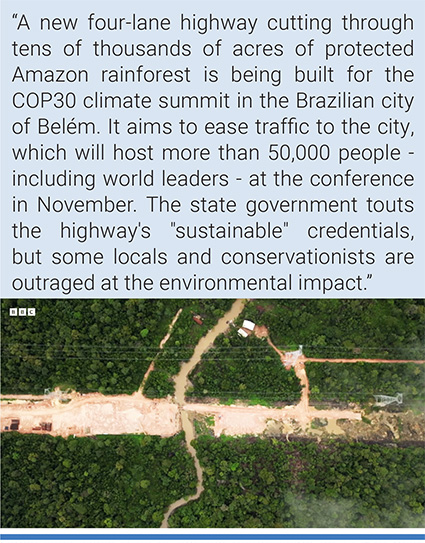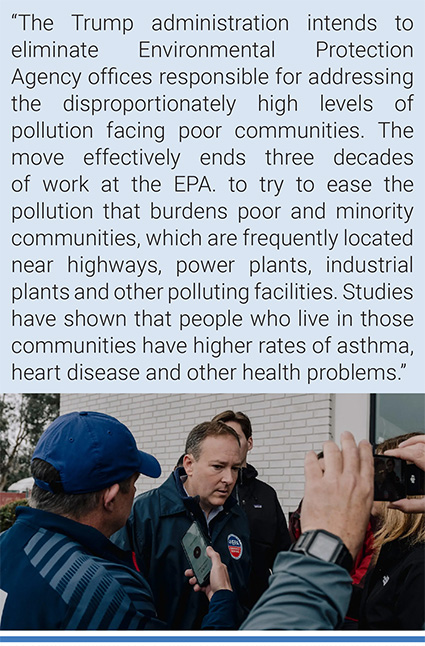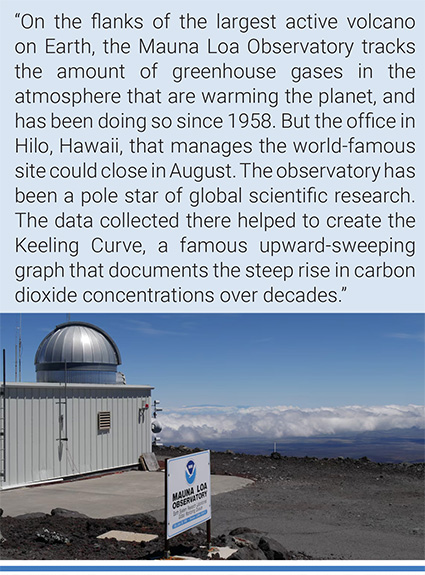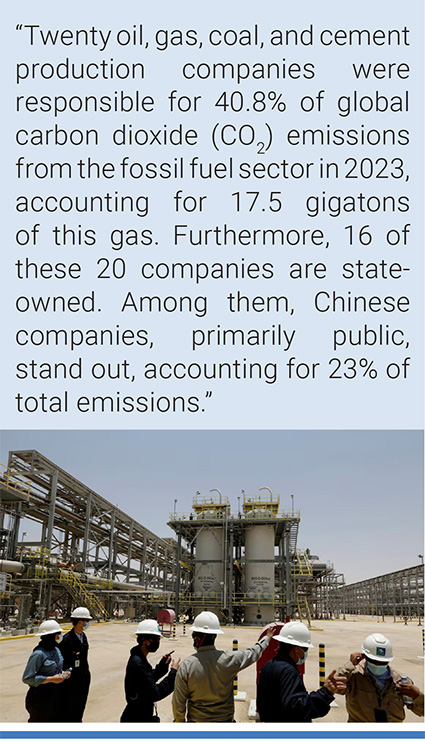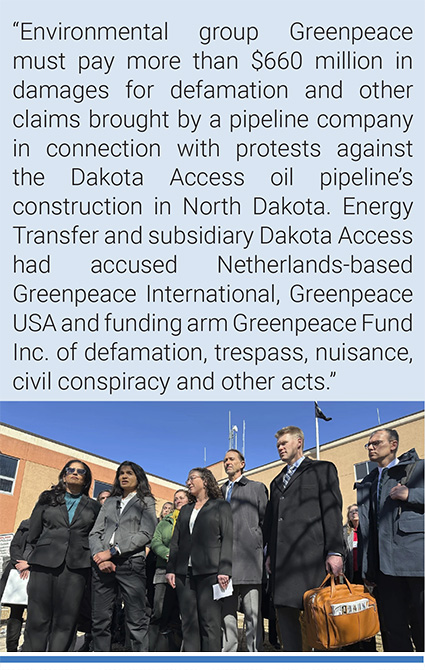Monthly Summaries
Issue 99, March 2025 | "Bearing the brunt of climate change"
[DOI]
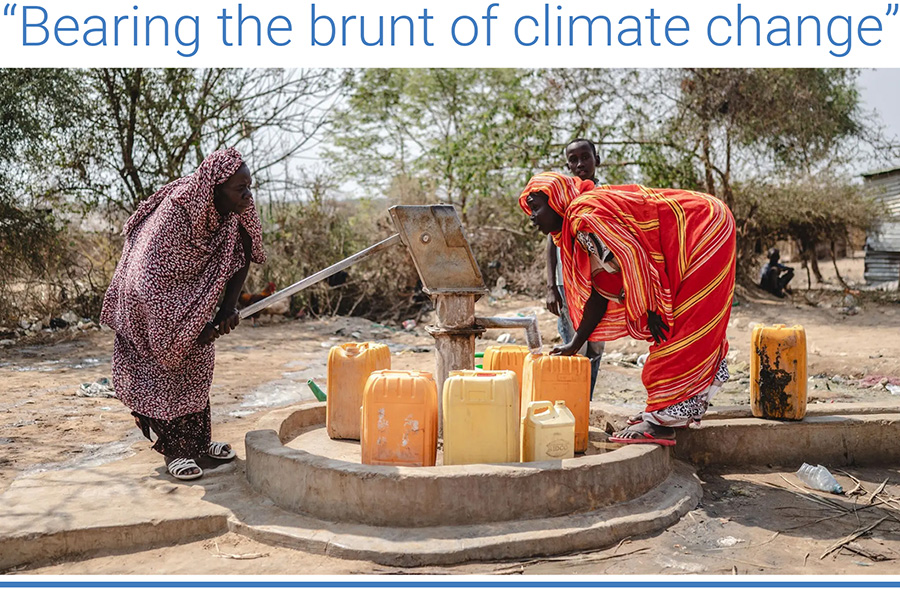
Displaced people collected water on the outskirts of Juba, South Sudan. Photo: Wang Guansen/Xinhua/Getty Images.
March media coverage of climate change or global warming in newspapers around the globe went up 7% from February 2025. However, coverage in March 2025 decreased 5% from March 2024. Figure 1 shows trends in newspaper media coverage at the global scale – organized into seven geographical regions around the world – across 21 years, from January 2004 through March 2025.

Figure 1. Newspaper media coverage of climate change or global warming in print sources in seven different regions around the world, from January 2004 through March 2025.
At the regional level, March 2025 coverage – compared to the previous month – increased everywhere but in North America (dipping slightly by 1%), Asia (decreasing 4%), and the Middle East (which dropped 12.5%): Latin America (+6%) (see Figure 2), the European Union (EU) (+9%), Africa (+21%), and Oceania (+33%). It appears that climate change news coverage largely took a back seat in March to other issues that were not linked to a heating planet. Meanwhile, comparing these March 2025 levels of coverage to a year previous (March 2024), counts increased only in Latin America (+4%), Asia (+11%), and Africa (+14%). Meanwhile, coverage dropped in the EU (-10%), Oceania (-12%), North America (-21%), and in the Middle East (-36%).

Figure 2. Coverage of climate change or global warming Latin America from January 2005 through March 2025: El Universal (México), Reforma (México), La Nación (Costa Rica), El Comercio (Perú), El Comercio (Ecuador), El País (Uruguay), La República (Uruguay), El Tiempo (Colombia), El Espectador (Colombia), La Razón (Bolivia), O'Globo (Brasil), Folha de S.Paulo (Brazil), La Nación (Argentina), Clarín (Argentina) and El Mercurio (Chile).
People queue to fill water during a heat wave at Chilla Village in New Delhi, India. Photo: Raj K Raj/Hindustan Times/Getty Images. |
Turning to content of March 2025 coverage, several stories drew on primarily scientific themes when reporting on climate change or global warming. For instance, New York Times journalist Austyn Gaffney reported, “After a blistering February heat wave in South Sudan’s capital caused dozens of students to collapse from heat stroke, officials closed schools for two weeks. It was the second time in less than a year that the country’s schools closed to protect young people from the deadly effects of extreme heat. Climate change, largely caused by the burning of fossil fuels in rich nations, made at least one week of that heat wave 10 times as likely, and 2 degrees Celsius hotter, according to a new study by World Weather Attribution. Temperatures in some parts of the region soared above 42 degrees Celsius, or 107 degrees Fahrenheit, in the last week of February. The analysis used weather data, observations and climate models to get the results, which have not been peer reviewed but are based on standardized methods. South Sudan, in the tropical band of East Africa, was torn apart by a civil war that led to independence from Sudan in 2011. It’s also one of the countries least responsible for the greenhouse gas emissions that are heating up the globe. “The continent has contributed a tiny fraction of global emissions, but is bearing the brunt of climate change,” said Joyce Kimutai, a researcher at the Center for Environmental Policy at Imperial College London. Heat waves are one of the deadliest extreme weather events and have become more frequent and more severe on a warming planet. But analysis methods connecting heat to mortality vary between and within countries, and death tolls can be underreported and are often unknown for months after an event. Prolonged heat is particularly dangerous for children, older adults and pregnant women. For the last three weeks, extreme heat has settled over a large region of continental Eastern Africa, including parts of Kenya and Uganda. Residents have been told to stay indoors and drink water, a difficult directive for countries where many people work outdoors, electricity is sporadic, access to clean water is difficult and modest housing means there are few cooling systems”.
Also, scientific findings of a new all-time low in global sea ice garnered media attention. For example, United Press International journalist Jesse Farrell wrote, “Global sea ice reached a new record low in February, according to the European Union's Copernicus Climate Change Service. This data, which combines the extent of sea ice from the Arctic and Antarctic, has records that date back to the late 1970s. Previously, 2023 held the record low for global ice following decades of decline. Scientists blame an Arctic heat wave for the new record, which prevented the normal growth of ice in February. Arctic sea ice reached its lowest monthly extent for February, at 8 below the historical average, Copernicus said. The Arctic had previously set a record low for minimum (summer) ice just last year in September”.
Later in the month, the World Meteorological Organization’s ‘State of the Climate Report’ was released and earned media attention. For example, CNN journalist Hilary Whiteman wrote, “A report considered the world’s most trusted source of climate updates has laid out the parlous state of a planet that has recorded its 10 hottest years over the last decade. The World Meteorological Organization’s State of the Global Climate report lists alarming records that scientists say should shock the world into taking drastic action – but they warn they probably won’t, given the lack of urgency displayed by global leaders to date. The report found the atmospheric concentration of carbon dioxide – as well as methane and nitrous oxide – are at the highest levels in the last 800,000 years”.
A boat travels through a frozen sea inlet outside in Nuuk, Greenland on March 6, 2025. Photo: Evgeniy Maloletka/AP. |
At the end of March, the University of Colorado National Snow and Ice Data Center reported record lows of Arctic sea ice. This earned media attention in several outlets. For example, Associated Press journalist Seth Borenstein reported, “Arctic sea ice had its weakest winter buildup since record-keeping began 47 years ago, a symptom of climate change that will have repercussions globally, scientists said Thursday. The Arctic reaches its maximum sea ice in March each year and then starts a six-month melt season. The National Snow and Ice Data Center said the peak measurement taken Saturday was 5.53 million square miles (14.33 million square kilometers) — about 30,000 square miles (80,000 square kilometers) smaller than the lowest previous peak in 2017. That’s a difference about the size of California. “Warming temperatures are what’s causing the ice to decline,’' ice data scientist Walt Meier said. “You know, sea ice in particular is very sensitive... 31 degrees is ice skating and 33 degrees it’s swimming.” Jennifer Francis, a scientist at the Woodwell Climate Research Center in Cape Cod, said this is yet another ringing alarm bell in the form of a broken record. “Disappearing sea ice is a particularly worrisome story because it’s truly an early warning system alerting us about a variety of hard-to-see changes,” Francis said in an email. Scientists said warming conditions in the Arctic — the region is warming four times faster than the rest of the world — affect weather elsewhere. Pressure and temperature differences between north and south shrink. That weakens the jet stream, that moves weather systems along, making it dip further south with cold outbreaks and storms that often get stuck and rain or snow more, according to the snow and ice center and Francis”.
Next, many media portrayals in March also focused on ecological and meteorological themes in various stories. For example, Times of India reporters wrote, “Climate change is rapidly intensifying, scientists warn that the cooling effects of La Nina may not be sufficient to offset the rising temperatures in a warming future. As India grapples with unusually high temperatures, the India Meteorological Department has predicted an early and intense summer this year, with prolonged heatwaves…human-caused climate change is leading to a ‘new normal’ of warmer winters and shorter springs. However, scientists emphasize that annual weather patterns, known as ‘year to year variability’ still play a crucial role in influencing seasonal conditions”.
Drone shots show scale of Amazon deforestation for COP30 road. Credit: BBC. |
Meanwhile, in the lead up to the UN climate negotiation later this year in Brazil BBC journalist Ione Wells broke the story writing, “A new four-lane highway cutting through tens of thousands of acres of protected Amazon rainforest is being built for the COP30 climate summit in the Brazilian city of Belém. It aims to ease traffic to the city, which will host more than 50,000 people - including world leaders - at the conference in November. The state government touts the highway's "sustainable" credentials, but some locals and conservationists are outraged at the environmental impact. The Amazon plays a vital role in absorbing carbon for the world and providing biodiversity, and many say this deforestation contradicts the very purpose of a climate summit. Along the partially built road, lush rainforest towers on either side - a reminder of what was once there. Logs are piled high in the cleared land which stretches more than 13km (8 miles) through the rainforest into Belém. Diggers and machines carve through the forest floor, paving over wetland to surface the road which will cut through a protected area”.
Elsewhere, in March people in Korea battled record-breaking wildfires that were linked to a changing climate. For example, New York Times correspondent Jin Yu Young reported, “At least 26 people have died in the worst wildfires on record in South Korea, massive infernos that have spread quickly over the past week, consuming hundreds of structures including two ancient Buddhist temples, officials said. The Interior Ministry gave the updated death toll in a report issued Thursday morning local time. It also said the blazes, which began last Friday, had scorched or were still burning across 88,000 acres of land in the country’s southeastern region — double the figure from the previous day. The largest blaze previously was in 2000, when fires blazed across 59,000 acres, killing two people, according to government archives. Flames and smoke have damaged 317 buildings across the region, according to the ministry. That includes the two temples, each more than 1,000 years old”. Meanwhile, Korea Times journalist Lee Hae-rin reported, “Wildfires that swept through southeastern Korea were possibly the worst in the nation's history, killing at least 27 people, destroying almost 37,000 hectares of forest and displacing more than 37,000 residents, the government said Thursday. The fire that started in Uiseong, North Gyeongsang Province, on March 21 is spreading at a record speed of 8.2 kilometers per hour as of 2 p.m., the fire authorities said. According to the Central Disaster and Safety Countermeasures Headquarters, 37,185 people had evacuated their homes as of 5 a.m. Thursday. Among them, 29,911 are from Uiseong and Andong in North Gyeongsang Province, where the wildfire damage is most severe. While 20,486 evacuees have returned home, 16,700 remained in shelters. The fires have destroyed over 2,572 buildings, including houses, temples and factories”. And Japan Times reporter Tomoko Otake wrote, “A series of wildfires that broke out in Japan and South Korea last week were fueled by human-induced climate change, according to a new rapid analysis released by a group of European researchers. ClimaMeter, a European Union-backed project studying the impact of climate change on extreme weather, said the ongoing wildfires in both countries were made more intense due to persistently dry soil, strong winds and unusually high temperatures. The wildfires erupted between Friday and Sunday and are still raging in Okayama and Ehime prefectures in Japan, as well as in parts of South Korea”.
EPA's administrator, Lee Zeldin, center, canceled hundreds of grants many of them designated for environmental justice. Photo: Mark Abramson/New York Times. |
Also in March 2025, political and economic-themed media stories persisted. Prominently, laying off workers and closing units within US federal agencies, some of whom work on climate change like the Environmental Protection Agency (EPA), the National Aeronautic and Space Administration (NASA), and the National Oceanic and Atmospheric Administration (NOAA). For an example of news stories on EPA cuts, New York Times reporter Lisa Friedman wrote, “The Trump administration intends to eliminate Environmental Protection Agency offices responsible for addressing the disproportionately high levels of pollution facing poor communities, according to a memo from Lee Zeldin, the agency administrator. In the internal memo, viewed by The New York Times, Mr. Zeldin informed agency leaders that he was directing “the reorganization and elimination” of the offices of environmental justice at all 10 E.P.A. regional offices as well as the one in Washington. Mr. Zeldin’s move effectively ends three decades of work at the E.P.A. to try to ease the pollution that burdens poor and minority communities, which are frequently located near highways, power plants, industrial plants and other polluting facilities. Studies have shown that people who live in those communities have higher rates of asthma, heart disease and other health problems, compared with the national average. “If anybody needed a clearer sign that this administration gives not a single damn for the people of the United States, this is it,” said Matthew Tejada, a former E.P.A. official who is now a senior vice president for environmental health at the Natural Resources Defense Council, a nonprofit organization. Molly Vaseliou, an E.P.A. spokeswoman, described the moves as “organizational improvements” that align with President Trump’s orders to end wasteful spending and diversity, equity and inclusion programs. In a statement, Mr. Zeldin suggested that environmental justice — which the agency defined as “the fair treatment and meaningful involvement of all people regardless of race, color, national origin, or income” with respect to environmental laws — was tantamount to discrimination”.
For an example of news accounts of NASA cuts, New York Times correspondent Kenneth Chang noted, “NASA is eliminating its chief scientist and other roles as part of efforts by the Trump administration to pare back staff at the agency’s Washington headquarters. The cuts affect about 20 employees at NASA, including Katherine Calvin, the chief scientist and a climate science expert. The last day of work for Dr. Calvin and the other staff members will be April 10. That could be a harbinger of deeper cuts to NASA’s science missions and a greater emphasis on human spaceflight, especially to Mars. During President Trump’s address to Congress last week, he said, “We are going to lead humanity into space and plant the American flag on the planet Mars and even far beyond.” Mr. Trump did not give a timeline for astronauts to reach the red planet, and during an interview on Fox News on Sunday, he said it was not a top priority. “Is it No. 1 on my hit list?” he said. “No. It’s not really.” He added, “It’d be a great achievement.” The administration sent notice to Congress on Monday that NASA was abolishing the Office of the Chief Scientist and the Office of Technology, Policy and Strategy”.
The Mauna Loa Observatory is connected to the Global Monitoring Laboratory, whose lease is set to expire this year. Photo: Susan Cobb/NOAA. |
For an example of media coverage of NOAA cuts, Washington Post journalist Scott Dance reported, “The Trump administration is planning to cancel its lease at a government laboratory in Hawaii, a site where scientists support key observations of surging greenhouse gas levels in the atmosphere, according to a list obtained by Democratic members of Congress and shared with The Washington Post. The Global Monitoring Laboratory in Hilo, Hawaii, is on a list of dozens of National Oceanic Atmospheric Administration facilities whose leases are set to expire later this year. The lab is connected to the Mauna Loa Observatory, where scientists gather data from atop a volcano to produce the famed Keeling Curve, a chart on the daily status of atmospheric carbon dioxide concentrations. The observatory itself is not on the list of potential closures, but staff in the Hilo lab work to maintain it, according to the lab’s website. Data collected from the observatory have shown global carbon dioxide levels — the most significant driver behind record planetary warming — are rising faster than ever recorded. Trump has been dismissive of that data and the consensus around climate change, and his allies who wrote the policy playbook Project 2025 proposed dismantling NOAA, calling it a source of climate alarmism. The Hawaii lab is one of several NOAA facilities on the list whose lease termination has not been previously reported, as the Trump administration and Elon Musk’s U.S. DOGE Service announce massive cuts to government real estate and personnel”. Meanwhile, New York Times correspondent Austyn Gaffney noted, “On the flanks of the largest active volcano on Earth, the Mauna Loa Observatory tracks the amount of greenhouse gases in the atmosphere that are warming the planet, and has been doing so since 1958. But the office in Hilo, Hawaii, that manages the world-famous site could close in August, according to a copy of an internal federal document viewed by The New York Times. The observatory has been a pole star of global scientific research. The data collected there helped to create the Keeling Curve, a famous upward-sweeping graph that documents the steep rise in carbon dioxide concentrations over decades. “These data are our eyes on the planet,” said Ralph Keeling, a climate science professor at the Scripps Institution of Oceanography at the University of California San Diego and the son of Charles Keeling, the curve’s creator. “It’s really vital base line data for how things are going to change going forward.” The observatory’s office is among 30 buildings operated by the National Oceanic and Atmospheric Administration, the nation’s leading agency for climate research, that are listed on the spreadsheet for possible lease terminations, beginning as early as May. It is unclear what would happen to operations at the observatory if the office were to close. White House Press Secretary Karoline Leavitt declined to comment, writing in an email, “As a matter of policy, we do not respond to reporters with pronouns in their bios.” Over the course of a day, the levels of carbon dioxide rise and fall, and within a year, there are seasonal variations. But the Keeling Curve shows the number has risen by more than 100 parts per million since 1958. In 2024, more carbon was emitted than ever before, and the average annual reading showed a record jump from the year prior. That rise has warmed the atmosphere, causing climate change that has led to more frequent and intense extreme weather events like heat waves, floods and wildfires”.
Relating to monitoring of extreme weather events, National Public Radio reporter Adam Kemp noted, “Meteorologists and climate scientists are raising alarms about major cuts to the National Oceanic and Atmospheric Administration, saying they will harm the country’s ability to forecast and respond to major weather events and put lives at risk. Hundreds of employees, including some of the country’s top meteorologists and researchers, had their jobs terminated on Feb. 27, part of a broader elimination of probationary employees by billionaire Elon Musk and his team at the Department of Government Efficiency. NOAA is now tasked with cutting an estimated 10 percent of its workforce, or 1,029 jobs, current and former employees told PBS News. If plans for these latest cuts move forward, nearly 20 percent of NOAA’s 13,000-person workforce would be cut. The federal agency is responsible for monitoring and forecasting weather across the U.S. and tracking climate trends. NOAA also oversees the National Weather Service and the National Hurricane Center, maintaining a network of radar systems, satellites and weather balloons to help predict and track extreme weather events. The agency’s research supports marine commerce by providing up-to-the-minute weather forecasting for cargo ships and other vessels. Beyond meteorology, NOAA’s research arm also manages fisheries, protects endangered marine life, monitors ocean health and studies the long-term effects of climate change”.
Vice-Premier Ding Xuexiang of China speaks at the 55th annual World Economic Forum annual meeting. Chinese officials touted the country's commitment to fighting climate change. Photo: Yves Herman/Reuters. |
While this unfolded in March in the US, China was ramping up its climate policy plans and this generated international media attention. For example, Canadian Broadcasting Corporation reporter Lisa Xing noted, “As U.S. President Donald Trump announces plans to withdraw from various international organizations and agreements, China is positioning itself as a global leader and capitalizing on the opportunity to fill a void left by the United States on the world stage, analysts say. On his first day in office after Monday's inauguration, Trump signed executive orders that started the process of pulling out of the World Health Organization (WHO) and the 2015 Paris Agreement on climate change, as he did in his first term. The moves by the Republican president call into question the future of global public health responses and climate goals and leave a leadership vacuum that China could try to fill. "This creates potential for China to further bolster its influence in the multilateral institutions of the world and help govern the world," said Gregory Chin, associate professor of political economy at York University in Toronto. Indeed, China appears to be sending those signals already”. As a second example, China Daily journalist Hou Liqiang reported, “China will take steps to respond to green trade barriers as it advances toward carbon neutrality, says the Government Work Report that was delivered at the opening of the third session of the 14th National People's Congress on Wednesday. The country will diligently work toward peaking carbon dioxide emissions before 2030 and achieving carbon neutrality before 2060, the report said. It listed a series of concrete measures to promote the targets. The country will steadily advance the second batch of trials to reach peak carbon dioxide emissions and establish a group of zero-carbon industrial parks and factories. The establishment of a framework for controlling the total amount and intensity of carbon emissions will be accelerated, and the national carbon trading market will be expanded to cover more industries. The report highlights measures the country will adopt in response to green trade barriers, which often entail implementing regulations that impose restrictions or requirements on imported products to ensure adherence to specific environmental standards. The country will keep carbon emissions statistics and undertake accounting initiatives and develop systems for managing carbon emissions and conducting carbon labeling and certification, the report said. More will be done to promote new energy development, it said. The country will speed up the construction of new energy bases in deserts and other arid areas, develop offshore wind farms and promote both the integration of renewable energy into local grids and the construction of transmission routes, it said”.
Saudi Aramco's plant in Al Hawiyah, Saudi Arabia. Photo: Amr Nabil/AP/LaPresse. |
In Europe, attention was also paid to fossil fuel producers and climate change in March. For example, El País journalist Manuel Planelles wrote, “Twenty oil, gas, coal, and cement production companies were responsible for 40.8% of global carbon dioxide (CO₂) emissions from the fossil fuel sector in 2023, accounting for 17.5 gigatons of this gas. Furthermore, 16 of these 20 companies are state-owned. Among them, Chinese companies, primarily public, stand out, accounting for 23% of total emissions. These are some of the conclusions drawn from a report prepared by the British research center InfluenceMap based on its Carbon Majors database, which tracks the contribution to climate change of the world's major fossil fuel producers and cement companies. In total, they counted the activity of 169 companies active in 2023, the latest year for which they have final data. And, according to these experts, despite the fact that the impacts of the climate crisis are intensifying, these companies' emissions grew by 0.7% in 2023 compared to 2022.” In addition, La Vanguardia journalist Anna Buj noted, “A new team at the European Commission, a new geopolitical situation, a new mandate. EU President Ursula von der Leyen had hinted that she would be flexible regarding the multi-million-dollar fines that car manufacturers would have to pay if they failed to meet emissions targets by 2025, but this Monday she formally opened the door. After enormous pressure from the sector, Brussels is proposing to extend the deadline from one to three years to achieve the decarbonization targets, which remain unchanged. This is the first outcome of the strategic dialogue launched in January to address the concerns of one of the sectors experiencing the greatest difficulties in the transition toward decarbonization. The European automotive industry, hit by factory closures and job losses—54,000 in the last year—is now also facing the tariffs announced by Donald Trump and the dependence on China for essential materials.”
There was also media attention paid to political and economic developments relating to climate change in South America in March. For example, El País journalist Francesca Raffo wrote, “Peruvian Farmer Brings German Energy Company RWE to Court for Melting Glaciers. For 10 years, Saúl Luciano Lliuya (45, Huaraz, Peru), a Peruvian mountain guide and farmer, has been waiting for this day. He knows that his entire journey is already a "historic event." A decade ago, Lliuya decided to sue German energy company RWE to hold it responsible for the melting of glaciers and the risks to more than 50,000 residents in Huaraz, an Andean city located 3,000 meters above sea level in the central highlands of Peru. What has happened since then has set a precedent: an individual successfully bringing a large company to court, a German court arguing that the complaint is legally sound and then reaching the evidence gathering phase. This Wednesday (March 19), the Higher Regional Court of Hamm, in the state of North Rhine-Westphalia, in eastern Germany, concluded the first hearing (which took place on Monday and Wednesday) of the civil lawsuit filed by Lliuya. The Peruvian, along with the German NGO Germanwatch and environmental law specialist Roda Verheyen, are hoping for a landmark ruling that would allow for fines against large broadcasters that accelerate climate change.”
In North America in late March, the US Trump Administration met with 15-20 major oil and gas representatives from the American Petroleum Institute. This generated media interest. For example, Washington Post journalists Maxine Joselow and Anna Phillips reported, “As Trump sat with the nation’s top oil and gas executives at the White House last week, he asked what was on their minds. In response, the executives asked for help battling climate Superfund laws, according to two oil industry representatives who spoke on the condition of anonymity to describe a private conversation. The Wall Street Journal first reported this request. Executives also complained about dozens of climate lawsuits brought by state and local governments against oil companies, the two industry representatives said. The lawsuits accuse the companies of deceiving the public for decades about the harms they knew their petroleum products would cause — an allegation the industry rejects. After listening to the executives’ concerns, Trump told a White House staffer to look for ways the administration could help, the two industry representatives said. The president did not commit to taking any specific actions, they said. Some industry executives want the Justice Department to sue New York and Vermont over their climate Superfund laws. The American Petroleum Institute (API), the U.S. oil and gas industry’s top lobbying arm, has already sued over Vermont’s law, alleging that it encroaches on the federal government’s power to regulate greenhouse gas emissions. The U.S. Chamber of Commerce, the nation’s biggest business lobby, joined the lawsuit filed in December. The two groups argued that Vermont lacked the authority to impose penalties on greenhouse gas emissions beyond its borders — an authority, they said, that the Clean Air Act reserves for the federal government. “This partisan legislation illegally and retroactively penalizes U.S. oil and natural gas producers for delivering the energy consumers need, and that should be a concern for our leaders in Washington,” Justin Prendergast, an API spokesman, said in an email. “We are exploring all options to correct this overreach by certain states.” Representatives for several executives who attended last week’s meeting — including the CEOs of Chevron, ConocoPhillips, ExxonMobil and Phillips 66 — declined to comment or did not return requests for comment. A White House official said the meeting focused on boosting oil production on federal lands in red states. Republican-led states are also coming to the industry’s defense. A coalition of 22 red states, led by West Virginia, sued New York over its climate Superfund law in February, arguing that it would put coal and oil producers out of business. Critics of climate Superfund laws also argue that they unfairly punish oil companies instead of consumers who use fossil fuels, whether to drive their cars or heat their homes”.
Greenpeace representatives outside the Morton County Courthouse in Mandan, ND. Photo: Jack Dura/AP. |
Last, there were several cultural-themed stories relating to climate change or global warming in the month of March. To illustrate, a successful lawsuit by Energy Transfer against the activist group Greenpeace garnered media attention in March. For example, Associated Press reporter Jack Dura wrote, “Environmental group Greenpeace must pay more than $660 million in damages for defamation and other claims brought by a pipeline company in connection with protests against the Dakota Access oil pipeline’s construction in North Dakota, a jury found Wednesday. Dallas-based Energy Transfer and subsidiary Dakota Access had accused Netherlands-based Greenpeace International, Greenpeace USA and funding arm Greenpeace Fund Inc. of defamation, trespass, nuisance, civil conspiracy and other acts. Greenpeace USA was found liable for all counts, while the others were found liable for some. The damages owed will be spread out in different amounts over the three entities. Greenpeace said earlier that a large award to the pipeline company would threaten to bankrupt the organization. Following the nine-person jury’s verdict, Greenpeace’s senior legal adviser said the group’s work “is never going to stop.” “That’s the really important message today, and we’re just walking out and we’re going to get together and figure out what our next steps are,” Deepa Padmanabha told reporters outside the courthouse”.
Meanwhile, as Trump Administration tariffs go into effect US consumers have expressed concern. President Trump’s comments about this generated media attention. For example, Wall Street Journal reporters Gavin Bade, Alex Leary and Kristina Peterson wrote, “The Trump administration is scrambling to determine the specifics of its new tariff agenda ahead of its self-imposed deadline of Wednesday, weighing options as the president has promised to remake the American economy with a swath of new levies. One key point of debate is whether to impose individualized tariff rates for U.S. trading partners, as President Trump has previewed in recent weeks, or revert to his campaign pledge for an across-the-board tariff that would affect virtually every country doing business with the U.S., say people familiar with the conversations”.

Figure 3. Examples of newspaper front pages with climate change stories in March 2025.
- report prepared by Max Boykoff, Rogelio Fernández-Reyes, Ami Nacu-Schmidt, Jeremiah Osborne-Gowey and Olivia Pearman

